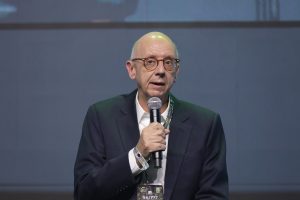Plinio Nastari, President of DATAGRO, is a renowned agricultural consulting professional with extensive experience spanning more than 50 countries. With a career marked by in-depth analyses and forecasts of the sugar and energy sectors, Nastari is a central figure in discussions on market trends and challenges. He recently shared his thoughts on harvest forecasts and market dynamics in the energy and sugar sectors in an interview with Canal – Jornal da Bioenergia.
 Channel – Journal da Bionergia: What are the main challenges facing plants this year, according to DATAGRO?
Channel – Journal da Bionergia: What are the main challenges facing plants this year, according to DATAGRO?
Pliny Nastari: In the 24/25 harvest season, we believe that the main challenges will be linked to the drier climate, which in some areas of the country requires a review of harvest and marketing planning. At the regulatory level, concerns revolve around the details of the tax reform and the treatment to be given to products with a high sugar content.
Channel: What is the current outlook for the sugar market? Does the increase in sugar exports last month indicate the direction of the entire 2024 crop?
Pliny: Brazil plays a crucial role as the largest supplier of sugar to the world market. In the case of bulk raw sugar, the country is responsible for nearly 80% of global exports. In the 23/24 harvest season, Brazil (Central, South, North and Northeast) exported 35.25 million tons of sugar. For the 24/25 harvest season, we estimate an exportable surplus of 34.28 million tons. The line of vessels continues to indicate a queue with specific volumes exceeding 3 million tons per month.
Channel: How have world conflicts and wars affected the price of Brazilian sugar on the international market? Is there any significant impact?
Pliny: Conflicts and wars, such as Ukraine, Russia, Israel and Hamas, have not affected the trade and price of sugar in the international market. The most relevant fact is that the global balance in the trade years 23/24 and 24/25 (October/September) indicates a very balanced situation. We expect a slight deficit of 1.1 million tons of raw sugar equivalent for 23/24 and a slight surplus of 0.5 million tons for 24/25. The trade flow showed a slight surplus in the case of 01proto and a slight deficit in the case of white sugar.
Channel: Are there any prospects for new markets for ethanol? Is partnership with hybrid vehicles a viable possibility?
Pliny: Beyond just opening new markets for ethanol exports, Brazilian producers have made significant efforts to expand the adoption of ethanol as a solution for land, sea and air transportation. These efforts are beginning to bear fruit, especially since ethanol produced in Brazil is certified and proven to be low in carbon intensity. This gives it great potential to enhance decarbonization, whether through direct use in vehicles and in river and sea transportation, or as an input to the production of other fuels, such as SAF (Sustainable Aviation Fuel) and green plastics.
Channel: What is the current scenario for bioenergy in Brazil in 2024?
Pliny: In 2023, the share of renewables in the Brazilian electricity matrix, according to the SIN (National Interconnected System) assessment, reached 93.0%. Bioelectricity contributed 8% of this total, maintaining the same share recorded in 2022. Hydropower represents 59.8%, wind energy 13.2%, solar photovoltaic 7%, electricity from fossil natural gas 5.3%, other petroleum derivatives 1.5%. and nuclear 2%. Bioelectricity is therefore a crucial component of the country’s electricity supply. Considering that 2024 is a drier year than usual, the importance of bioelectricity increases, as a stable energy generated in a way that complements the seasonal hydropower system. With a drier year, the level of reservoirs should decrease, and the price of the settlement difference (PLD), calculated by the Chamber of Electricity Commerce (CCEE), should reflect this less favorable climate condition.
Channel: The policy projects being voted on, such as the “Cradle to Grave” policy in the Future Fuels Program, the Green Mobility and Innovation (Mowafir) project, and the Energy Transition project in the Senate, represent a victory for the sugar sector?
Pliny: Adoption of the “cradle to grave” concept or Life Cycle Assessment (ACV) in the calculation of carbon emissions of vehicles, adopted in the Mover Program and adopted by Deputy Arnaldo Jardim in his working report on the Fuel Bill for the Future These measures, which are being processed in the Federal Senate, represent a victory for the entire society and place Brazil at the forefront of the world in terms of modern and advanced regulation. This concept is considered by scientific circles to be the most complete and decisive, providing predictability and regulatory security to guide investments in sustainable mobility and the energy transition. Precisely for this reason, investments in Brazil exceeding 130 billion reais have already been announced in the coming years.
Channel: How does RenovaBio contribute to diversifying production and reducing carbon emissions in Brazil, and what are the potential benefits and challenges in updating its principles?
Pliny: We have followed the efforts of several producer groups and their representative entities to promote the diversification of production and the full use of the energy contained in the main sources of biomass, such as sugarcane and corn, as well as their co-products and waste. Brazil is moving towards the production of bioenergy products with a low carbon intensity, which creates interesting opportunities for the various production chains to promote effective emission reduction, while ensuring the certification of the origin of the products according to the most stringent international standards. This is the great value and legacy of RenovaBio, which must be appreciated and preserved, including updating and modernizing some of its principles, if necessary. (Channel – Bioenergy Magazine)


